APRIL 25, NYC: Kodak's New York press event today announced three new products (two hardware and one software), and gave an interesting glimpse into some of the near-future technology the Kodak engineering team is working on. The new products announced were the new Kodak V610, the 2006 edition of the Kodak EasyShare One, and Version 6 of Kodak's EasyShare Software.
The V610 is the second in what's apparently to be a series of "Retina" cameras, having two complete lens/CCD systems. The original V570 combined a 23mm ultra-wide lens with a conventional 3x zoom lens. The new V610 combines two zoom lenses, a roughly normal-range 3x, going from medium wide to medium telephoto, and a telephoto zoom that goes from medium to long telephoto. The overall zoom range is 10x, in a camera body only slightly larger and thicker than that of the original V570 (under an inch thick.) The V610 also includes the exceptional auto panorama stitching of the V570, as well as the Kodak Perfect Touch processing introduced with that model for very effective automatic tone and color correction.
The 2006 version of the EasyShare One addresses one of the chief criticisms of the original model, namely it's rather low sensor resolution of 4 megapixels. The new 2006 EasyShare One boosts this to 6 megapixels, much more in line with other digital cameras it competes with.
Kodak's free EasyShare Software has always been a favorite recommendation of mine for non techno-savvy friends: Kodak took an early lead in making photo management and printing software truly easy to use. Now in its 6th generation, Kodak reports that its EasyShare software is installed on no less than 30 million computers worldwide, making it far and away the most widely deployed consumer imaging software. The new version 6 sports a substantially redesigned user interface, with most of the tools quietly sitting in the background until they're needed. The design aesthetic of the software is to focus all the user's attention on the photos themselves, rather than the tool. Kodak's feeling is that this increased emphasis on the photos (which after all, is what it's all about) will inspire users to do more with them - and getting people to do more with their photos is obviously critical to Kodak's business plans and future revenue.
The press event today was held at the "Top of the Rock", high atop Rockefeller Center in New York City, and was blessed with bright, sunny weather, a relief for the Kodak PR folks after the stormy day that preceded it. Apart from a fair bit of atmospheric haze and the need to shoot through the glass protective barriers on the observation deck, this was a perfect environment to show off the 10x zoom and panoramic capabilities of the new V610. I shot a few wide-to-tele comparison shots, as well as a couple of panoramas, the best of each are shown below.
| Wide (38mm equivalent) | Telephoto (380mm equivalent) |
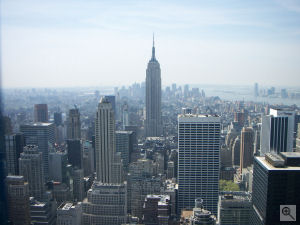 | 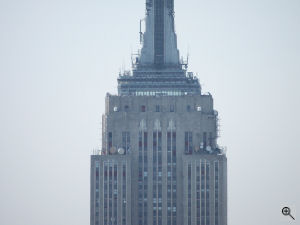 |
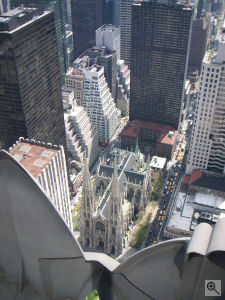 | 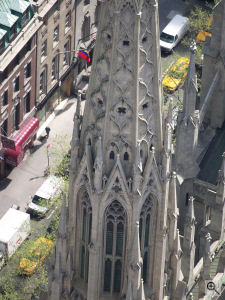 |
Panoramas (stitched in-camera) |
 |
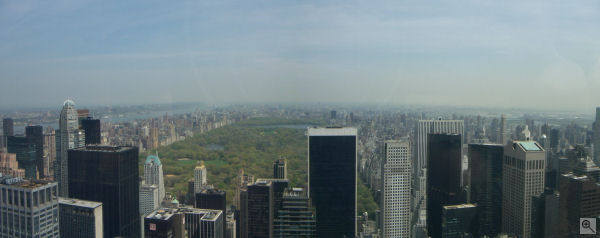 |
Apart from the new products being announced today, Kodak shipped a number of their research scientists and product-development folks down from Rochester NY, to show off some of the technology that's poised to make its way out of the back labs. What we saw was pretty impressive, and appears to be far enough along that it might make it into the retail market relatively soon. (My own assessment, as you might expect, Kodak was keeping pretty close-mouthed about when to expect any of this at retail, but what was on display appeared to work pretty well, with few rough edges in evidence.)
The key to all the future technology was to make sharing photographs easier than ever, even photos that far predate the digital era.
One of the most impressive demos I saw was a high-speed print scanner system that could accept prints ranging from a couple of inches on a side up to 11x17, and scan them at a rate of two prints per second. (!) The scanning hardware itself is actually already on the market, in use for high-speed scanning of checks and air-express waybills. Given the high monetary value associated with each scanned document in those applications, the scanning mechanism has been constructed for very high reliability and very gentle treatment of the documents being handled. (We didn't see it demonstrated, but Kodak claims it can actually scan tissue paper reliably.) Two photos per second strikes us as about what you'd need to do, to entice people to scan their proverbial shoeboxes of old family photos: A stack of 100 disappears in less than a minute, so it's quite feasible to scan a thousand or more photos per batch.
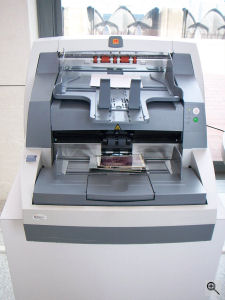 |
Kodak high-speed photo print scanner |
The scanning speed alone was impressive enough, but even more so was the level of smarts built into the software, aimed at intelligently categorizing and organizing incoming photos by decade. The scanner reads both sides of the photos simultaneously, so it can pick up and recognize via optical character recognition any back-printing on the images. It can also recognize hand-written dates on the backs of the photos. As if that weren't enough, the software contains a database of all sorts of date-correlated information gleaned from Kodak's years of retail photofinishing -- Things like what year they introduced rounded corners on 2 1/4 inch square prints, specific dimensions and aspect ratios of various types of prints, all manner of barely-legible watermarks on the back of the photo paper, indicating the type and characteristics of the paper itself, etc, etc. The net result is a system that can do a surprisingly good job of figuring out (to within a decade's resolution at least) when a print was made, over the last 50 years or so. From the consumer's viewpoint, they just dump a shoebox full of images in one end of the process, and a digital archive pops out the other, organized by decade. Very slick.
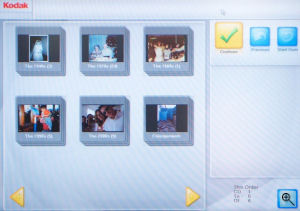 |
Kodak high-speed photo print scanner - interface |
But (as they say on the infomercials) "that's not all!" Other software on display could take batches of images and group them (within each decade) by similar subject content -- Similar mixes of color, backgrounds, etc. So all your vaction photos from the trip to Yellowstone National Park end up grouped together, separate from the shots at Johnny's birthday party. But that's not all: Face-recognition software built into the package not only recognizes faces, but extracts various metrics from them (spacing between the eyes relative to spacing of eyes/nose/mouth, shape of face, etc), so it can group together photos containing images of the same people. (Provided of course, that full-face views are available: Profile shots still defy accurate characterization.)
Having scanned through all the photos, organized them by decade, and grouped them by content and subject identities, a last step in the software is to spit out automatically-formatted photo albums, able to be printed and bound by Kodak's EasyShare Gallery's output services.
This collection of technology strikes me as huge: The ability to digitize and automatically organize even vast shoebox collections of photo prints promises to pull years of memories out of dusty closets and make them available for sharing. Even more importantly, the speed of the scanning process means it can be a while-you-wait proposition, so consumers need never lose sight or contact with their precious photo memories. This overcomes a huge barrier that previous attempts at digitizing old family photos haven't been able to overcome.
As noted, Kodak wasn't saying anything about when all this technology would make it out to the general market, but a limited retail test in a few locations around Kodak's headquarters in Rochester, NY is under way right now.
ES-1, Phone Home
All of the above was pretty impressive, but a couple of things maybe spoke more about the future of cameras in general and Kodak cameras in particular than all else combined. Kodak stated that they expected that "most" digital cameras would be internet-connected in one way or another by the end of the decade. I'm not sure that I'm quite as sanguine as they are about that, but there's no question that WiFi and Bluetooth are going to be finding their way in to many more cameras with each passing year. The most significant thing I saw though, was what looked like a conceptual demo, of someone carrying on a VOIP (voice over internet) conversation via their EasyShare One camera. We've seen a lot of cell phones with limited-quality cameras built into them on the market, this was the first evidence I've seen of the "convergence" phenomena happening from the other direction, cameras moving into voice communications. It makes sense and probably should have been obvious really, but I confess to having an "aha!" moment when I saw the demo: WiFi connection to the internet, microphone, speaker, full IP protocol stack built into the camera ... of course, voice communications! I don't think Motorola and Nokia have much to worry about Kodak cameras eating into their cell phone market share, but seeing convergence moving from both directions somehow made it seem more like a real phenomena to me, rather than just something the analysts beat the drum about.
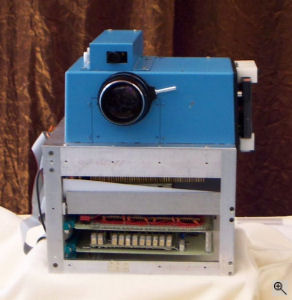 |
The first Digital Camera, circa 1976 |
As a parting shot, and an indication of just how far we've come, Kodak had the engineering prototype of what they claimed was the first digital still camera on display. An ungainly collection of circuit boards and rough-machined aluminum, the device was perhaps 6-8 inches on a side, and had "something under QVGA (320x240) resolution". Quite a ways from that to today's 6-megapixel 10x-zoom, Bluetooth-equipped pocket-sized V610. One can only speculate what the next 30 years will bring...